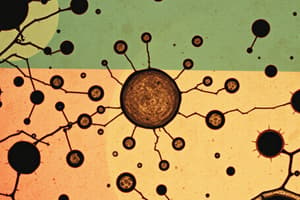Podcast
Questions and Answers
What is the primary energy currency of the cell?
What is the primary energy currency of the cell?
- Lipids
- Protons
- ATP (correct)
- Calcium
Which organelle contains the genetic material (DNA) of the cell?
Which organelle contains the genetic material (DNA) of the cell?
- Ribosomes
- Nucleus (correct)
- Endoplasmic Reticulum
- Cytoskeleton
What is the main function of the endoplasmic reticulum?
What is the main function of the endoplasmic reticulum?
- Energy production
- Cell movement
- Protein synthesis (correct)
- Regulating gene expression
Which structure provides structural support and enables cell movement?
Which structure provides structural support and enables cell movement?
In which stage does cell replication occur in the cell cycle?
In which stage does cell replication occur in the cell cycle?
What is the key function of transport proteins in the cell membrane?
What is the key function of transport proteins in the cell membrane?
What is the function of the plasma membrane?
What is the function of the plasma membrane?
What do all cells share in common?
What do all cells share in common?
Which cells have a cell wall composed of chitin and other polysaccharides?
Which cells have a cell wall composed of chitin and other polysaccharides?
What is the meaning of 'selectively permeable' in relation to the cell membrane?
What is the meaning of 'selectively permeable' in relation to the cell membrane?
Study Notes
Exploring Cell Structure: A Comprehensive Guide to the Cellular World
On the current date, February 6, 2024, let's explore the fascinating world of cells and their structures. In this article, we'll delve into the intricate details of cell structure, which is a subtopic of cell biology.
Cell Structure: The Building Blocks of Life
Cells are the basic building blocks of all living organisms. They serve as the fundamental units of life, responsible for carrying out essential functions for the organism's survival and growth. Cells come in different shapes and sizes, but they all share common structural components that enable them to function as living units.
Plasma Membrane
The plasma membrane is a flexible, yet strong barrier that separates the cell's interior from its external environment. It plays a vital role in regulating the movement of substances in and out of the cell, as well as maintaining the cell's shape and stability.
Cell Wall
The cell wall encases most bacteria and fungi cells, providing structural support and protection. Prokaryotic cells (bacteria and archaea) have a rigid cell wall made of peptidoglycan, while fungi cells have a cell wall composed of chitin and other polysaccharides.
Cell Membrane Transport
The cell membrane is selectively permeable, meaning it only allows certain substances to pass through it. Transport proteins such as channels, carriers, and pumps facilitate the passage of molecules across the membrane, enabling selective uptake and efflux of substances.
Proton Gradient
The plasma membrane contains specialized transport proteins called ATP synthase that harness the flow of protons across the membrane to generate ATP, the primary energy currency of the cell. This proton gradient is a key component in cellular respiration and energy production.
Cell Organelles
Cells contain specialized organelles that perform specific functions. Some of the most important organelles include:
- Nucleus: The cell nucleus contains the genetic material (DNA) and is responsible for regulating gene expression.
- Endoplasmic Reticulum: A network of membrane-bound structures that function in protein synthesis, lipid metabolism, and calcium storage.
- Ribosomes: These are cellular structures where proteins are synthesized.
Cytoskeleton
The cytoskeleton is a network of protein filaments that provides structural support and enables cell movement, maintaining shape, and facilitating intracellular transport. The cytoskeleton is composed of three primary types of protein filaments: actin, microtubules, and intermediate filaments.
Cell Cycle
The cell cycle is a series of events that occur during the life cycle of a cell. It consists of four main stages: G1 (Gap 1), S (Synthesis), G2 (Gap 2), and M (Mitosis). The cell cycle enables cell growth, replication, and division.
Conclusion
The study of cell structure is an integral component of biology, providing a foundation for our understanding of life at the molecular level. From the plasma membrane to the cytoskeleton, the cell's structural components enable essential functions, ensuring the cell's survival and growth. By understanding cell structure, we can gain a deeper appreciation of the complexity and intricacy of life at the microscopic level.
Studying That Suits You
Use AI to generate personalized quizzes and flashcards to suit your learning preferences.
Description
Delve into the fascinating world of cell structure and its significance in the study of cellular biology. From the plasma membrane to the cytoskeleton, explore the intricate details of cell components and their functions.




